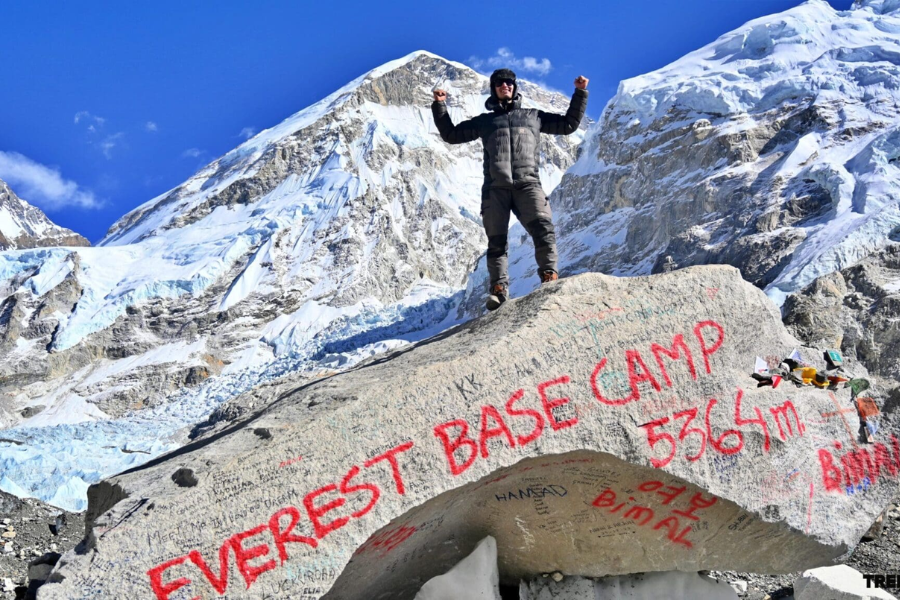The Ultimate Packing List for Your Everest Base Camp Trek in 2024
Embarking on the Everest Base Camp trek requires careful consideration of your packing list to ensure a successful and comfortable adventure. The trek, known for its challenging conditions and high altitudes, demands specific gear and equipment that can handle the variable weather and rugged terrain of the Himalayas.
Firstly, selecting the right clothing is crucial. You’ll need a layered approach to manage the range of temperatures you’ll encounter. Start with a moisture-wicking base layer that keeps sweat away from your skin, followed by insulating mid-layers like fleece or down jackets to retain body heat. The outer layer should be a waterproof and windproof shell to protect against rain, snow, and strong winds. It’s also wise to pack a lightweight down vest or jacket that provides extra warmth without bulk.
Footwear is another key consideration. Invest in high-quality, waterproof trekking boots that offer good ankle support and traction on uneven surfaces. Make sure they are well-broken in before your trek to avoid blisters and discomfort. It’s also beneficial to carry a pair of comfortable, lightweight camp shoes for use during rest stops and at your accommodations. Everest Base Camp Trekking Safety
When it comes to gear, a sturdy, well-fitting backpack is essential. Look for one with sufficient capacity to carry your gear, including a sleeping bag rated for cold temperatures and a durable, collapsible trekking pole for stability on challenging terrain. A hydration system, such as a Camelbak or water bottles, along with water purification tablets or a filter, is necessary for staying hydrated and ensuring access to safe drinking water.
Pack essential accessories like a high-quality headlamp or flashlight with extra batteries, as well as a multi-tool for unexpected repairs. A first-aid kit tailored for trekking, including items like blister treatment and altitude sickness medication, is crucial for handling minor injuries and health issues on the trail. Personal items such as sunscreen, lip balm with SPF, and insect repellent are important for protection against the elements.
Additionally, don’t forget to include a good-quality camera or smartphone for capturing the stunning landscapes, and a power bank or solar charger to keep your electronic devices charged. Travel documents, including your passport and trekking permits, should be kept in a waterproof case for safekeeping.
In conclusion, your packing list for the Everest Base Camp trek should be meticulously planned to address the diverse challenges of high-altitude trekking. Prioritize layers, sturdy footwear, essential gear, and personal items to ensure you are well-prepared for a memorable and successful journey to the base of the world’s highest peak.
Introduction to Packing for the Trek
Packing for the High Altitude Trekking Safety is a crucial aspect of preparation, as the right gear and clothing can significantly impact your comfort and safety during the journey. The trek, which involves traversing varied terrain and enduring high-altitude conditions, requires careful selection of items that offer functionality, durability, and adaptability to unpredictable weather. Packing wisely ensures that you are well-equipped to handle the physical demands of the trek while staying comfortable and protected.
The process begins with understanding the specific requirements of the trek and assessing the weather conditions you might encounter. The Everest Base Camp trek spans multiple days and involves exposure to both cold and potentially wet conditions, making it essential to pack items that can be layered and adjusted according to changing temperatures. Proper packing also involves considering the weight and space of your gear, as you’ll need to carry everything in a backpack while maintaining mobility and ease of access.
By focusing on essential clothing, footwear, and gear, you can prepare effectively for the trek, ensuring that you have the necessary equipment to tackle the challenges of the high-altitude environment and rugged terrain. A well-thought-out packing list will contribute to a smoother, more enjoyable trekking experience, allowing you to concentrate on the adventure and the stunning landscapes that lie ahead.
Essential Clothing Items
Proper clothing is fundamental to a successful Everest Base Camp trek, given the extreme and variable weather conditions. Each layer of clothing serves a specific purpose in managing temperature, moisture, and protection against the elements.
Base Layers
Base layers are the foundation of your clothing system, designed to wick moisture away from your skin and keep you dry and comfortable. They are typically made from materials like merino wool or synthetic fabrics that offer excellent moisture-wicking properties and thermal insulation. Base layers come in various weights, so selecting a lightweight or mid-weight option based on the season and your comfort level is essential. For the trek, a few long-sleeve shirts and thermal bottoms are recommended, as they provide a breathable barrier against the cold while allowing for easy layering.
Insulating Layers
Insulating layers are crucial for retaining body heat and providing warmth in colder conditions. These layers are usually made from fleece, down, or synthetic materials that trap heat effectively. A good insulating layer should be versatile and easily removable, allowing you to adjust your clothing based on changing temperatures. For the Everest Base Camp trek, a mid-weight fleece jacket and a high-quality down or synthetic puffy jacket are ideal choices. These layers will help maintain warmth during colder nights and rest breaks, ensuring that you stay comfortable throughout the trek.
Outer Layers
Outer layers are essential for protecting against wind, rain, and snow. They are typically made from waterproof and windproof materials such as Gore-Tex or similar fabrics. A well-designed outer layer should include a waterproof jacket with a hood and adjustable features to provide a barrier against harsh weather conditions. In addition, a pair of waterproof pants will protect your lower body from rain and snow, while also providing an extra layer of warmth. Ensuring that your outer layers are breathable and lightweight helps in maintaining comfort while allowing for flexibility and ease of movement on the trail.
Footwear Requirements
Footwear is one of the most critical components of your gear for the Everest Base Camp trek, as it directly affects your comfort and safety on the challenging terrain.
Trekking Boots
Trekking boots are essential for providing stability, support, and protection on the varied and often rugged terrain encountered during the trek. Nepal Trekking Adventures A high-quality pair of waterproof trekking boots with good ankle support is crucial to prevent injuries and ensure comfort. The boots should be durable, with a robust outsole that offers excellent traction on uneven surfaces. It’s important to choose boots that fit well and are broken in before the trek to avoid blisters and discomfort. Insulated boots may also be necessary to provide warmth in colder conditions, particularly at higher altitudes.
Camp Shoes
Camp shoes are a secondary but important item for comfort during the trek. After long days of trekking, a pair of lightweight, comfortable camp shoes allows your feet to relax and recover. These shoes are typically used around the campsite, in lodges, or at rest stops. Options include sandals, flip-flops, or lightweight slip-on shoes that are easy to pack and provide a comfortable alternative to trekking boots. They should be durable enough to handle varying surfaces, yet lightweight and breathable to keep your feet comfortable during downtime.
Sleeping Gear
Good quality sleeping gear is essential for a comfortable and restful night’s sleep on the Everest Base Camp trek, helping you recover and prepare for the next day of trekking. The right sleeping gear ensures that you stay warm, dry, and comfortable in the varying conditions you’ll encounter at high altitudes.
Sleeping Bags
A high-quality sleeping bag is crucial for staying warm and comfortable during the trek, especially given the cold temperatures at higher elevations. For the Everest Base Camp trek, you will need a sleeping bag rated for temperatures well below freezing. Down-filled sleeping bags are popular due to their superior insulation and warmth-to-weight ratio, but synthetic options are also available and perform well even when damp. Ensure that the sleeping bag you choose is compact and lightweight, as it needs to fit comfortably in your backpack without adding excessive weight. A bag with a draft collar and a hood provides additional warmth by minimizing heat loss. Consider bringing a sleeping bag liner for extra warmth and to keep the sleeping bag clean.
Sleeping Pads
A sleeping pad adds another layer of insulation between you and the cold ground, which is critical for maintaining warmth and comfort. For the Everest Base Camp trek, a high-quality, insulated sleeping pad is recommended. Inflatable or self-inflating pads with adequate thickness and insulation provide cushioning and thermal protection. Look for a pad with a high R-value, which measures its insulating ability, to ensure it will perform well in the cold temperatures you might encounter. Additionally, a compact and lightweight design is essential for ease of packing and carrying. Proper inflation and maintenance of the sleeping pad are also important to ensure it remains comfortable throughout the trek.
Backpack and Daypack Essentials
Choosing the right backpack and daypack is vital for managing your gear efficiently and ensuring you have access to essential items throughout the trek. A well-designed backpack and daypack contribute significantly to your comfort and organization during the journey.
Backpack
A sturdy, well-fitting backpack is essential for carrying your gear, including sleeping gear, clothing, and food. For the Everest Base Camp trek, a backpack with a capacity of 50 to 65 liters is generally suitable, providing enough space for your gear while remaining manageable. Look for a pack with adjustable straps, a padded hip belt, and a good ventilation system to ensure comfort and distribute weight evenly. Features such as multiple compartments and easy access points help in organizing your gear and keeping frequently used items within reach. A rain cover is also important to protect your gear from the elements.
Daypack
A smaller daypack is useful for carrying essential items on day hikes and during trekking excursions. This pack should be large enough to hold items like water, snacks, a first-aid kit, and extra clothing, but small enough to be carried comfortably. A daypack with padded shoulder straps and a hip belt provides additional comfort and support. Look for features such as hydration reservoir compartments and external pockets for easy access to frequently used items. The daypack should be lightweight and durable, designed to handle the demands of daily use while keeping your essentials readily accessible.
Trekking Equipment
Proper trekking equipment enhances stability, safety, and comfort during the trek, addressing specific needs related to terrain and hydration. Investing in high-quality trekking equipment ensures a more enjoyable and successful trekking experience.
Trekking Poles
Everest Trekking Logistics Trekking poles are an invaluable tool for maintaining balance and reducing strain on your legs during the trek. They provide stability on uneven terrain, assist with uphill and downhill climbs, and help in managing the physical load of carrying a backpack. Look for trekking poles that are adjustable, lightweight, and equipped with comfortable grips. Shock-absorbing features can further reduce impact on your joints, making the trek more comfortable. Collapsible or folding poles are ideal for packing and convenience. Practicing proper pole techniques and adjusting them to your height can enhance their effectiveness and improve overall trekking performance.
Hydration Systems
Maintaining proper hydration is crucial for performance and health during the trek, particularly at high altitudes where the body dehydrates more quickly. Hydration systems, such as Camelbak reservoirs or water bottles, are essential for keeping water easily accessible while trekking. A hydration system with a built-in filter or purification tablets ensures that you have access to safe drinking water from various sources. Consider carrying a backup water purification method to address any potential issues with water sources. Ensuring that your hydration system is easy to use, lightweight, and compatible with your backpack’s hydration reservoir compartment or side pockets helps in managing your fluid intake efficiently throughout the trek.
Personal Care Items
Personal care items are crucial for maintaining hygiene, comfort, and well-being during the Everest Base Camp trek. With the limited access to facilities along the trail, it’s important to pack items that address both basic hygiene and personal comfort needs.
Firstly, pack biodegradable soap and hand sanitizer for cleaning hands and face. A small, quick-drying towel will be useful for personal hygiene and drying off after washing. For dental care, include a toothbrush, toothpaste, and dental floss. Moisturizers and lip balm with SPF are essential to prevent chapped skin and lips caused by the cold, dry air at high altitudes.
Don’t forget a small personal care kit with items like a razor, comb, and any other toiletries you might need. Feminine hygiene products should be included if applicable, as well as a small, compact mirror for convenience. Personal medications, including any prescribed drugs, over-the-counter pain relievers, and supplements, should be packed in their original packaging to avoid issues at customs or during the trek.
Lastly, consider packing a small bag or organizer to keep these items together and easily accessible. Proper personal care contributes to your overall comfort and health, allowing you to focus on the trek rather than any discomfort or hygiene issues.
First Aid Kit Essentials
A well-equipped first aid kit is indispensable for addressing minor injuries and health issues that may arise during the Everest Trekking Challenges. The challenging conditions and remote locations necessitate having a comprehensive kit to handle common medical situations effectively.
Your first aid kit should include adhesive bandages in various sizes for treating cuts and blisters. Sterile gauze pads and medical tape are useful for wound care, while antiseptic wipes and ointment help prevent infection. Pain relievers, such as ibuprofen or acetaminophen, can alleviate common aches and pains. Additionally, include medications for altitude sickness, such as acetazolamide (Diamox), as well as anti-nausea and anti-diarrheal medications for gastrointestinal issues.
Tweezers and a small pair of scissors can assist in removing splinters or cutting bandages. A thermometer is useful for monitoring body temperature in case of fever. Additionally, a multi-tool with knife and pliers can be handy for a variety of needs. Don’t forget to pack any personal medications, as well as a first aid manual or guide for reference. Regularly check and replenish your first aid kit before the trek to ensure it is complete and up-to-date.
Cooking and Eating Utensils
Cooking and eating utensils are important for preparing and consuming meals during the Everest Base Camp trek. While many trekkers rely on lodges or teahouses for meals, bringing your own cooking equipment ensures you can manage meals and snacks effectively on the trail.
A lightweight, compact stove or cooking system, such as a canister stove, is ideal for preparing hot meals and drinks. Make sure to carry sufficient fuel and a lighter or matches in a waterproof container. A small, durable cooking pot or pan, along with a spork or multi-functional utensil, will be necessary for preparing and eating food.
Pack a collapsible sink or container for washing dishes, and a small sponge or cloth for cleaning. For food storage, use resealable plastic bags or lightweight containers to keep snacks and ingredients fresh. Consider including a few small, high-energy snacks like trail mix or energy bars for quick nourishment on the go. If you plan to cook, bring lightweight, non-stick cookware that’s easy to clean and carry.
Lastly, ensure that all cooking and eating utensils are durable and easy to pack, minimizing weight and space in your backpack while still meeting your needs for meal preparation and consumption.
Navigation and Safety Gear
Navigation and safety gear are essential for ensuring that you stay on track and are prepared for emergencies during the Everest Base Camp trek. Given the remote and challenging nature of the trek, having the right equipment can significantly impact your safety and overall experience.
A reliable map and compass are fundamental tools for navigation, helping you stay oriented and track your progress along the trail. Ensure that you are familiar with their use before starting the trek. A GPS device or smartphone with GPS capabilities can provide additional navigation support, especially in challenging sections where trails may be less clear.
A personal locator beacon (PLB) or satellite messenger is crucial for emergency situations, allowing you to send distress signals and communicate with rescue teams if necessary. A high-quality headlamp or flashlight with extra batteries is essential for visibility during early morning starts or evening hikes, and it also serves as a safety measure if trekking extends into darkness.
A whistle is a simple yet effective tool for signaling for help if needed. Additionally, pack a small multi-tool or knife for various tasks, and a first aid kit as discussed previously. Proper navigation and safety gear, combined with knowledge of their use, ensure that you are well-prepared for a safe and successful trek to Everest Base Camp.
Stay tuned for the latest news and updates on tamasha


